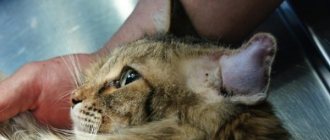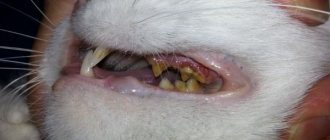Cats can suffer from many pathologies, which may go unnoticed at first. However, if a lump appears on a cat’s neck, it immediately attracts attention and causes great concern among the owners. What it is and what to do in this case – we’ll look at it in the article.
Whatever the reason for a tumor on your cat’s neck, you should seek help from a specialist. In any case, we are not talking about a temporary phenomenon (with rare exceptions). Unfortunately, treatment does not always involve lubrication with ointments or pills. The consequences can be very serious. And everything will depend on why the cat’s neck is swollen.
The owner will not be able to determine what exactly this lump is. To a non-professional, neither the size, nor the shape, nor the density of the formation can tell anything about why a lump appeared on the neck. This means that, with all your love for the cat, you will not be able to actively help in treating and ridding the cat of the tumor. What to do?
Risk factors
In the vast majority of cases, owners of older animals encounter neoplasms on the withers and neck of cats. The appearance of soft cones and balls is due to the natural aging of the animal’s body. Risk factors for this:
- The pet is over 8 years old;
- Endocrine disorders;
- Obesity;
- Presence of parasites.
Only a veterinarian can accurately identify the nature of the lump, the cause of its appearance and suggest treatment methods. Self-medication in the presence of formations in pets is not allowed.
Treatment
It is not recommended to independently treat any growth or lump on a pet; you only need advice and help from a qualified specialist. The veterinarian chooses the treatment method taking into account the established diagnosis, the general condition and age of the animal, and concomitant diseases.
- The most negative diagnosis is a malignant tumor on the spine or other organ . Such formations are removed surgically.
- In the case when the disease is only at the second stage, the cat has many chances to be completely cured; for this, it needs to undergo a course of chemotherapy and immune therapy.
- Benign tumors are removed surgically ; in most cases they do not pose a threat to the life of the cat. But still, the owner of the animal should not let the situation take its course.
- If a lump appears on the nose or above the eye due to an allergy, skin infection, or hormonal imbalance, the veterinarian may prescribe specific complex therapy . Its course is often short and includes the use of internal and local agents. With correct diagnosis and accurate adherence to doctor’s instructions, the lump will resolve. If there is pus under the skin, it will drain out.
Rehabilitation therapy plays an important role in recovery . In the presence of metastases, chemotherapy is prescribed, and it is also used in cases where surgery is impossible. Unfortunately, in the later stages of cancer, even these treatment methods rarely help; more often, veterinarians recommend euthanizing the animal and ending its suffering, since the pet is also experiencing severe pain .
Abscess on the neck
A lump on your cat's neck may be an abscess. This is a cavity filled with pus. It appears at the sites of wounds and injuries, and may be a consequence of skin irritation by parasites, in response to which the pet scratched the wound.
Abscess symptoms:
- Homogeneous structure of the neoplasm.
- Redness and increased temperature of the skin around the affected area.
- Pain when pressing.
With an abscess, the cat is constantly trying to reach the tumor. If she can't scratch her neck with her paw, she starts rubbing herself against the furniture. Thus, the animal tries to get rid of the annoying lump on its own.
Since an abscess is a purulent inflammation, a general deterioration in the pet’s well-being is possible. The cat may become lethargic or, on the contrary, irritated and refuse to be handled.
Only a veterinarian can quickly relieve an animal of discomfort. The abscess is opened with a scalpel, then the cavity filled with pus is cleaned out and the wound is treated with antiseptic. If necessary, the doctor may apply stitches and prescribe antibiotics to prevent the inflammation from reoccurring.
You may be interested in: How to protect a cat from toxoplasmosis: routes of infection, symptoms, treatment and prevention.
An abscess can open on its own, but this is dangerous for the animal’s health. The cat can lick off the purulent contents, but there remains a risk of re-infection of the resulting wound.
Detailed description of possible causes
If a cat’s neck is swollen after taking any medications, then this reaction cannot be ignored, since an allergy to medications is considered very dangerous and can cost the pet’s life. It’s bad when this symptom appears in an animal after a walk down the street and the owner can only guess what could have caused it. Therefore, we list the most common options that can lead to varying degrees of severity of neck swelling in cats:
- Hematoma. A distinctive feature of a hematoma is the color and size of the formation. At first glance, it seems that the cat’s neck is swollen, but by touching it, you can understand that it is a lump, inside of which liquid (baked blood) is concentrated. For large hematomas, an incision is made to drain out the lymphatic fluid. If necessary, the wound is drained, as the fluid can come out within 2-3 weeks.
- Injection. If your pet has received any injections in the withers area, then there is always a risk of seroma, abscess and hematoma forming in this place. At first glance, it may seem that the cat’s neck is swollen, but after palpating this area, it becomes clear that the problem lies in a neoplasm, which can be hard to the touch and cause pain in the animal. Abscesses are usually opened and cleared of pus, and a drain is placed to drain fluid during the healing process. Hematomas often resolve on their own within 2-3 days, provided they are no larger than a walnut.
- Insect bites. First of all, we are interested in stinging insects, after the bites of which a cat may not only have a swollen neck, but also severe redness of the skin and terrible itching. Most often, animals suffer from stings of wasps and bees, less often from bumblebees and hornets. In many cases, pets do not even leave their homes; unfortunately, wasps often fly into open windows even in noisy cities. On the one hand, stinging insect bites do not pose a significant danger to the health of the animal, but on the other hand, the area of the neck, larynx and tongue can in rare cases cause suffocation. Therefore, in case of severe swelling, it is better to immediately take your pet to the veterinarian, as this could cost him his life. Small swellings go away on their own within 24 hours; symptoms can be reduced with the help of antihistamines (suprastin or diphenhydramine).
- Eosinophilic granulomas. It is considered an independent disease, but many veterinarians classify it as a type of allergy. When lesions form on the mucous membrane, they look like bleeding ulcers, skin rashes are more like fly or gadfly bites. A cat’s neck may become swollen after scratching the granulomas until they bleed. Also, in areas where lesions are localized, hair may fall out and the skin may become inflamed. Small, single formations can be observed without any therapeutic measures, as they often go away on their own. For multiple lesions, hormonal therapy can be used over a long period. To make a diagnosis, cytology and histology of cells taken from the lesions are performed.
- Bacterial infection. Even a small wound can cause severe swelling if it gets infected and the inflammatory process begins. A cat's neck may become swollen after a fight in which it received deep scratches from claws or bites from teeth. Small wounds usually heal without any consequences within 1-2 days, but if swelling, redness and traces of pus appear, this may indicate the development of an inflammatory process. In difficult cases, it is necessary to open the wound and clean it of pus and lymphatic fluid. Anti-inflammatory and regenerating ointments are used for healing. Antibiotics are also prescribed at the discretion of the doctor. The absence of pus and redness can be considered a complete recovery; when healing, the wound becomes covered with a crust, which disappears on its own. It is recommended not to allow your pet to scratch the lesions, as this may not only delay the healing process, but also cause a secondary infection.
Now you know that the most dangerous cases in which cats have a swollen neck are associated with an allergic reaction, which can be caused by taking medications or stinging insect bites.
Lump on a cat's neck photo
Features of operations to remove such tumors
Such formations, first of all, should not be enucleated, that is, only the tumor itself should not be removed. According to the rules of oncological surgery, they must be removed, taking into account the surrounding tissues, taking into account their anatomical location, taking into account the blood and lymph circulation in this area. This means that it is better to contact a qualified oncologist or surgeon to ensure that this formation is excised correctly and to reduce the likelihood of relapse and further spread of the tumor.
Surgical intervention for tumors in animals is not considered in terms of simple surgical excision alone. Such important points are assessed as, firstly, whether this excision will improve the quality of life of the animal, and secondly, whether the animal will continue to live adequately, whether it will be mobile after the operation and how long the rehabilitation period will be. All these points are taken into account by the oncologist surgeon.
If he considers the intervention appropriate, if there is a possibility that this intervention will be successful, it is carried out. If this intervention is crippling, if it does not improve the quality of life of the animal, or if the prognosis is unfavorable, then there is no question of surgery.
Malignant neoplasms
A soft lump on a pet's neck can pose a threat to the cat's life. In older animals, the appearance of a neoplasm may indicate oncology.
Malignant lumps do not have specific symptoms; only a specialist can make a diagnosis. As a rule, with cancer, a cat feels unwell and lacks strength, refuses to eat, and begins to lose weight. Since these symptoms are common to other diseases, you should immediately show the animal to a specialist.
To make a diagnosis, the doctor will do an X-ray or MRI. If a malignant tumor is suspected, a biopsy is performed - removal of particles of the tumor for the purpose of histological examination of tissue cells. Based on the results of histology, a decision is made on further treatment. The lump must be completely removed, and the animal is prescribed a course of chemotherapy.
Methods of assistance and treatment
The decision to remove the tumor should be made together with a specialist.
Before making a decision to fix the problem, it is imperative to consult a specialist.
Benign tumors
Benign tumors are eliminated by surgery and, as a rule, no complications arise. Does not give metastases. In some cases, surgical removal is not necessary if the lump does not compress the blood vessels and does not increase in size.
Tumors
The veterinarian will help determine the nature of the tumor.
Tumors of an infectious, allergic or hormonal nature are treated through the use of specific therapy.
- Usually the course lasts no more than three days and restricts access to the allergen.
- If the cause is inflammation of the lymph nodes, camphor oil is prescribed for local treatment, which is rubbed into the seal.
- The tumor resolves or spontaneously opens and leaks pus.
Insect bites or scratches
As a result of insect bites or scratches, a swelling filled with purulent exudate may also appear.
- If the cat does not have an increase in body temperature, it is acceptable to use warm compresses to prevent the spread of infection.
- If there is a fever, the abscesses are opened surgically, cleaned, and washed.
- In order to prevent further infection, antibiotic therapy is prescribed.
Abscess
You can eliminate a small abscess without the help of a doctor.
If the abscess is small, you can eliminate it yourself at home.
- To do this, carefully, adhering to all the rules of asepsis and antisepsis, remove the crusts from the surface of the wound.
- It is first necessary to disinfect the affected area.
- Then slowly squeeze out the purulent liquid and rinse the wound cavity with a solution of hydrogen peroxide.
- Repeated cleansing as the wound fills with liquid.
Cancerous tumors
Typically, cancerous tumors are removed using surgery.
It is advisable to remove cancerous tumors at an early stage surgically, followed by restorative therapy.
- If the cancer has already metastasized and the tumor cannot be operated on, chemotherapy may be prescribed. However, with a large affected area, therapy will not give positive results.
- In this case, it is best to euthanize the animal.
- Radiation exposure is used less frequently.
- If the cat's cancer is approximately at the second or early third stage, it would be advisable to use chemotherapy in combination with immune therapy.
- In approximately half of the cases, this approach provides a complete cure or stops the progression of the disease. For cats, human drugs are usually used - ASD and ASD-2.
Lipoma
If it is a lipoma, your veterinarian will prescribe appropriate treatment.
If the identified cause is a lipoma - a wen, then treatment depends on the doctor’s recommendations.
Surgical removal of such a problem is usually practiced if the wen grows and bothers the pet. Less often, the doctor recommends leaving the wen if it does not increase in size and does not cause discomfort to the cat.
The appearance of strange formations under the skin of a pet is not that uncommon. They can be malignant or benign, become inflamed, cause discomfort to the cat, ooze exudate (serous or purulent) or be absolutely painless and not annoy the pet in any way. But any subcutaneous formations in a pet deserve the owner’s attention.
Lipomas in cats
If a cat has a soft lump on its neck that easily rolls under your fingers and does not cause discomfort to the pet, a lipoma or wen is a possible cause.
The reason for the appearance of such seals is the peculiarity of the functioning of the animal’s sebaceous glands. The formation of lipomas is often associated with endocrine disorders and obesity in older animals.
Wen themselves are not dangerous, but must be removed, especially if they are located on the pet’s neck or head. The fact is that a benign lipoma can begin to degenerate into cancer with age, so veterinarians recommend removing lipomas in a timely manner.
What to do if the lump is bleeding or discharges pus
If the cat owner notices that the tumor has begun to bleed or that pus is oozing from it, then this is a very dangerous symptom that indicates a malignant formation.
Note! Sometimes a cat's lump under the skin on its abdomen can also be an abscess, which can rupture on its own. It is highly undesirable to wait for this, as the pet will experience pain and suffering. Even after septic treatment, pus may still be released for some time, so the wound must be treated and washed.
Very often, cats develop bumps that frighten their owners. The percentage that they are malignant is quite low, so if a neoplasm is detected, you need to take your pet to the doctor’s clinic as quickly as possible for a medical examination and to rule out the worst cases of the disease.
What diseases can be caused
There are many diseases that cause a lump on the neck. Interstitial fluid, immune cells, and blood accumulate inside it. Each cause has a different treatment and must be diagnosed. The sooner this is done, the higher the chance of saving the cat’s life and health.
A lump under a pet's jaw should alert any owner
Benign and malignant neoplasms
A benign neoplasm is an increase in the number of different tissues that lead to a tumor. Benign means there are no stem cells that can spread throughout the body, causing metastases and organ damage. The tumor itself is not dangerous, but as it grows, the nervous and vascular tissues are compressed and neighboring organs are damaged.
A malignant tumor on the neck of a cat is the presence of mutated cells similar in structure to stem cells. They gradually multiply and increase in size. When cancer migrates through blood vessels, metastases form in the kidneys, liver, and brain. There they lead to dysfunction and gradual death of the animal.
Important! Both conditions are similar in the initial stages. Tumors can also develop on the neck, forming a lump.
Lipoma
Lipoma is a benign neoplasm. The lump appears due to the accumulation of fat cells that form a capsule around themselves. The formation is not dangerous until it begins to compress the blood vessels and nerve tissues in the neck. If it reaches a large size, it can make it difficult to breathe and move food through the esophagus.
Abscess
An abscess is an accumulation of fluid in a capsule. It can develop in any part of the body. An abscess is dangerous because purulent exudate can accumulate inside it, the capsule will burst, and the liquid will spread throughout the intercellular substance, entering the vessels. This will cause sepsis and death of the cat without long-term treatment.
Inside the abscess there is interstitial fluid with admixtures of immune cells that have penetrated into the cavity. A ball appears on the neck under the skin of a cat, which can occur as a result of mechanical damage, inflammatory and infectious processes, compression of tissue by a collar and other reasons.
Lymphadenitis
The disease occurs due to excessively enlarged lymph nodes. They can hypertrophy due to the following reasons:
Note! Lymph nodes cannot develop to enormous sizes with a single exposure to a pathogenic microorganism. The cat must often suffer from diseases, which will gradually lead to an increase in tissue. It can grow to such a size that it interferes with normal chewing of food, breathing, and blood circulation.
Ixodid tick
The parasite lives in plants, it clings to the animal’s fur, gradually moving to its skin. The tick attaches itself through the skin, feeding on blood. Many species of ixodid ticks carry borreliosis, hemorrhagic fever, and meningoencephalitis.
Some types of ticks carry infections, viruses that lead to the formation of bumps on the skin. This is a focus of inflammation in which immune cells, tissue fluid, and pathogens accumulate.
Important! The immune system actively fights the infection, lymphocytes release inflammatory mediators, which further enlarges the lump on the cat’s neck.
Insect bites and scratches
Some cats may live outside temporarily or permanently. There are also insects that inject poison when they bite an animal. This causes an immune reaction. Lymphocytes, eosinophils, and mast cells accumulate in the lesions. They begin to release inflammatory mediators, which forms a tumor on the cat’s neck. In fact, this is a compaction that is temporary. When the inflammatory reaction is complete, the immune system will destroy the tactical substance, and the lump will go away on its own.
Note! Many owners notice that their cat's neck is swollen after being scratched. If it is not treated, an infection may enter the wound, which will also cause an inflammatory reaction and swelling.
Benign tumors
Most often, it is recommended to eliminate them through surgery. In this case, complications occur extremely rarely, due to the absence of metastases. When the lump is small in size, has no tendency to grow and does not bring a destructive effect to the body, it is not removed.
We invite you to familiarize yourself with Veterinary assistance in poultry farming for farmers
As for the treatment of growths between the shoulder blades of an infectious, allergic, and hormonal nature, special therapies are used for this:
- Often the treatment course is three days. During this period, the animal’s access to the allergen is limited;
- If the pathology is inflammatory, camphor oil is rubbed into the seal;
- The pathology is opened, the contents are removed and antiseptic treatment is carried out.
Moscow
- Veterinary clinic White Fang. There is a branch in Kaliningrad. They work around the clock. There is an MRI machine. There is an oncology department.
- Network of veterinary clinics Medvet. Vilkovysky I.F. - chief physician, head of the surgical department, leading surgeon. Candidate of Veterinary Sciences.
- Veterinary center Komondor. Wide range of veterinary services. There is an animal rehabilitation unit. The clinic’s doctors are active participants in veterinary conferences and symposiums.
We invite you to familiarize yourself with Alopecia in cats: causes and treatment











